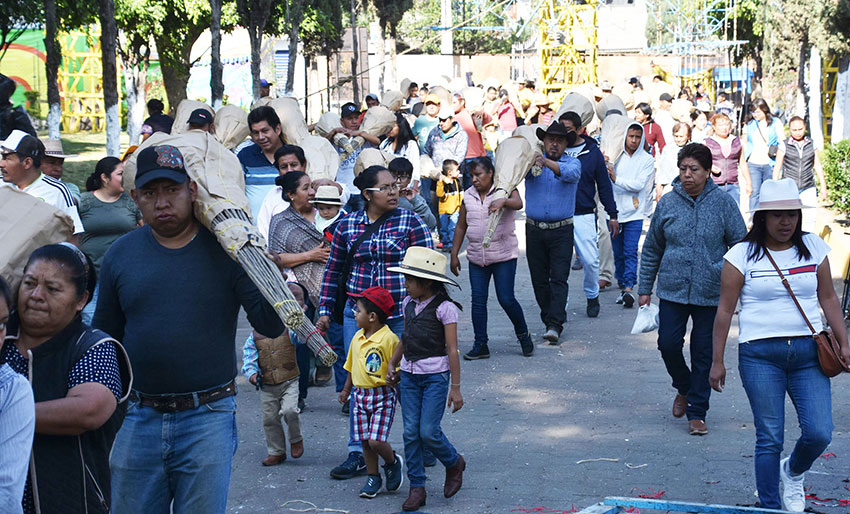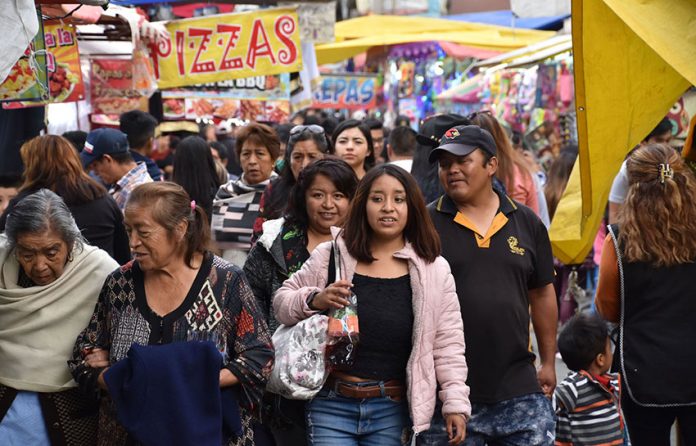San Gregorio Atlapulco, a pueblo of about 30,000 residents that is part of Mexico City, is woefully unprepared for the coronavirus.
San Gregorio is a pueblo originario (original town), a designation acknowledging that it has maintained many of its indigenous traditions.
This means, in part, that there are fiestas. A lot of fiestas. In fact, I’ve been told there are 365 a year and that’s probably an underestimate. There are fiestas for a large number of saints and virgins; there are dozens of processions for a variety of reasons; there are a number of pilgrimages; every time a new mayordomo (a lay religious figure) is installed, there’s a fiesta. There are something like 300 mayordomos.
Every fiesta features bottle rockets, bands and processions and are attended by dozens or often hundreds of people. In normal times, that’s a good thing. The fiestas are loud, fun, and have great food, lots of tequila and, with hundreds or even thousands of people attending, strengthen community. But these are anything but normal times.
Last week featured the Feast Day of San Gregorio, the pueblo’s patron saint. It started on March 12 and lasted 10 days. On Sunday the 15th, several bands played in the local cemetery, a tradition meant to entertain the deceased. At least 50 people were there.
This was followed by a battle of the bands attended by several hundred people. On Monday morning, there was a procession with a couple of hundred people. That night was the huge fireworks display in the church’s atrium. And I do mean huge.
Three castillos — 100-foot-tall structures crammed with fireworks — dominated the event, which also featured a fireworks display that would be the envy of any major U.S. city’s 4th of July celebration. It probably lasted two hours with a couple of thousand people in attendance. I watched in the distance from my balcony.
Every night this week, there’s been a concert with different kinds of music. I walked past them a couple of nights and there were several hundred people crammed into the civic plaza. A friend asked me why I didn’t attend the concert on one particular night. The band played classic rock.
“It was great,” he said. “They played The Doors, Stones, Creedence.” I told him I was busy. He’s someone who should know about the current risks of being in a large crowd. He’s the manager of the small medical clinic.
I’ve been to the clinic twice since I moved here last year — once to treat some cuts I got when I was knocked over by a horse, once to remove blackened toenails that were the result of walking some 12 hours through mountains on the pilgrimage to Chalma, a holy site. I was pleased with the care both times.
But there’s no way this clinic can handle people who get sick from the virus. There are no beds. There are no test kits. I’d be shocked if they had adequate masks. Forget respirators. I don’t know where the nearest hospital is but wherever it is, it will soon be overwhelmed.

Social distancing has become the most popular phrase in the U.S. media. I’ve seen it used in some of the larger Mexican newspapers, and some Mexican friends have mentioned (and are practicing) it, but it’s definitely not being followed in San Gregorio.
I really don’t know if it can be. There’s simply no way to practice social distancing in the local market. It’s small, located on two narrow streets and it’s crowded every day. Most people, including me, have no way to store fresh food for more than a day or two, so we typically go to the market two or three times a week. I’ve started buying more fruit that can be kept unrefrigerated.
San Gregorio isn’t some isolated pueblo where we could think we’re safe because there’s little contact with Mexico City proper. Many people work there, which means a two-hour trip riding in two micros (small buses) and then the Metro subway. They’re still packed. And, at least up until two weeks ago, things hadn’t changed much in the city. I was there because I had to wrap up an article. The Metro, streets and restaurants were all filled.
The virus, if not already in the pueblo (and I doubt that it isn’t), is on its way but most of the people I talk with about it shrug off the dangers. “No pasa nada,” said one friend: Nothing will happen. Several people have told me that Mexicans are different; they’re stronger because they eat a lot of chiles. A couple of people have told me to drink more tequila, something I definitely enjoy doing but not for its virus-fighting capabilities.
I’ve seen several large signs warning about coronavirus painted on walls in three of the pueblos I’ve been in. It looks like they’re being done by local governments because the federal government’s response has been uneven at best. Just a couple of days ago, President Lopez Obrador said he was protected from the virus by the two amulets he always carries with him.
But, although I fear what will happen in the pueblo when the virus really settles in, there are at least two things that will help us get through the pandemic. First, there’s the incredibly strong sense of family and community. People help one another during crises.
The most recent example was when an earthquake struck in September 2017. There was no hesitation: people got to work helping, feeding, rebuilding. I know that when people get sick, they’ll be cared for. The other thing that may help us get through this is the chinampería.
The chinampería (sometimes simply called the chinampa) is an ancient agricultural area that was formed by building small islands in shallow water. San Gregorio is one of the few pueblos where chinampas are still used to grow food. Hundreds of people (called chinamperos) still work there and I believe, no matter what, we’ll always have fresh vegetables.
Even if many chinamperos got sick, there’s enough institutional memory in the pueblo to keep the area productive. Last week, city residents asked me to talk with chinamperos to see if they’re willing to deliver food to them. They are.
There are ruins in the hills surrounding the pueblo that are at least 1,000 years old. There’s a Neolithic site in the chinampa that dates back 4,000 years. Just last week I photographed a carving my good friend Javier discovered there; it’s 6,000 to 8,000 years old. The pueblo has seen its share of crises and disasters over the milenia. Although I worry that the virus will exact a terrible toll, I’m confident the pueblo will find a way through it.
Joseph Sorrentino is a freelance writer and photographer currently living in San Gregorio Atlapulco, which is part of Xochimilco. His articles and photographers have appeared in In These Times, Commonweal Magazine, US Catholic and La Jornada del Campo and other newspapers and magazines.
